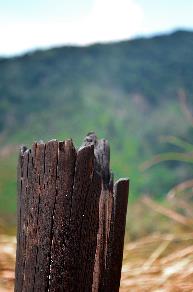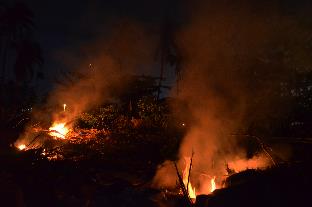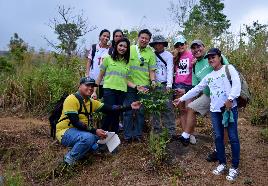How firebreaks, educating the public can save PH mountains

UNDER CONTROL Trekkers who evacuated Mt. Apo on Sunday watch from a safe distance smoke from the fire raging in the northwestern side of the country’s highest peak. The forest fire that started on Saturday has already been contained, according to city officials. RYAN MARK ASTURIAS/CONTRIBUTOR
Clearly, El Niño, dry vegetation and fire don’t mix.
Mt. Apo is the country’s highest. Mt. Kanlaon is known as the tallest of all Visayan peaks. Bud Bongao is recognized the holy mountain of Tawi-Tawi. They have one thing in common–all are in flames.
Mt. Apo and Bud Bongao are burning because of campfires while Mt. Kanlaon discharged super-heated rocks to ignite vegetation baked dry by El Niño. In April 2015, Mt. Kanlaon also lost 29 hectares due to an errant campfire.
As of posting, Mt. Kanlaon is on fire, covering 400 hectares of grassland.
READ: Fire near Mt. Kanlaon razes 400-ha grassland
Article continues after this advertisementDry weather and wind can quickly spread fire to adjacent areas. Mt. Apo already lost 300 hectares and the flames are still raging.
Article continues after this advertisementThe consequences are dire. In Indonesia, uncontrolled forest fires consumed millions of hectares of forest and have taken years to quell.
READ: Strong winds rekindle fire in Mt. Apo; wild animals flee
So what can be done to save our summits?

Philippine forests are also cut down and burnt for charcoal. This is all that remains trees, like this one in photo, in Central Luzon. CONTRIBUTED PHOTO/Gregg Yan
The first solution is to quickly create firebreaks when a brushfire begins. Firebreaks are unbroken lanes from six to ten feet wide, cleared of all vegetation. Looking like dirt roads, firebreaks can greatly reduce fires from spreading further.
The next solution is to enforce the ban on kaingin or the controlled but illegal burning of land.
During El Niño spells, kaingin is usually very hard to control. Wind can pick up embers and cause fires far away from kaingin plots.
The third solution is for mountaineers and trekkers to police their camps. Campfires should be immediately banned and stoves used only in open ground, at least six feet from dry vegetation.
Spilled fuel or a knocked-over stove is all it takes to ignite dry tinder and turn a mountain into a giant pyre.
Smoking must be banned on mountains as cigarette butts smolder long after being snubbed out.
“Leave No Trace” principles must be the lifeblood of all mountaineers: take nothing but pictures, leave nothing but footprints, kill nothing but time.

Fires smoldering in Southern Luzon. Though illegal, the open burning of vegetation is still widespread in the Philippines. CONTRIBUTED PHOTO/Gregg Yan
What must be done when a brushfire abates? Reforest the area right before the rains come in, usually in June.
Plant only native Philippine trees–species already naturally found in the area. Don’t introduce foreign tree species or biodiversity will be affected.
The summer has just started and already, three of the most famous Philippine peaks are ablaze.
Local government units, management bodies and communities must immediately look into firebreaks and education before more peaks join the conflagration.

Representatives from Republic Cement and WWF at a well-managed tree planting site in Rizal. CONTRIBUTED PHOTO/Gregg Yan
SOS this time means Save Our Summits!
TVJ
Gregg Yan is an environmentalist who has climbed over a hundred mountains in the Philippines and Asia. He was recognized by Readers’ Digest as one of the most trusted Filipinos in 2013.